Orion Introduction
Orion Accessories
![]() News
News ![]() Products
Products ![]() Pricing
Pricing ![]() Distribution
Distribution ![]() Notes & Interesting Articles
Notes & Interesting Articles
![]()
![]()
![]() Mounts
Mounts
![]() Telescopes
Telescopes
![]()
Orion SkyView Pro™ 100mm ED EQ 4 Inch f9 Apo Refractor
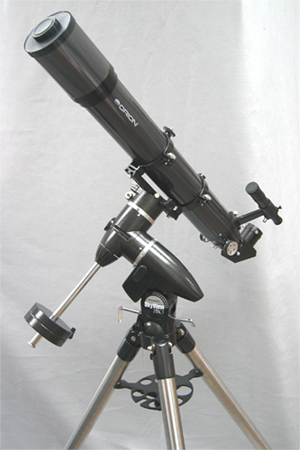
The Orion SkyView Pro™ 100mm ED EQ telescope went on display in Company Seven's showroom on 6 August 2004; we were the first in the nation (maybe in the world) to show this new telescope.
Right: SkyView Pro™ 100mm ED EQ telescope. Also available for sale as an optical tube assembly alone. (61,288 Bytes).
Click on image to see enlarged view (227,566 bytes)
The introduction in late 2003 of the Orion 80mm ED telescope was greeted with much praise and enthusiasm. The Chinese maker contracted by Orion to produce this new telescope proved China was becoming a force to be reckoned with, in some terms tickling the more upscale market areas of optics. The 80 ED demonstrates it is possible to buy a telescope that does not claim to be the finest in the world but is one heck of a good balance between aperture, focal length, overall optical performance and cost. Not long after the introduction of the 80 ED we assumed the design would be scaled up to produce a telescope with a larger aperture, one that would be even more suited for astronomical applications, and finally in August 2004 Orion introduced the 100mm ED telescope.
Orion developed this 100mm telescope lens design so that it can be readily produced solely for Orion and deliver a rewarding experience on the planets or deep sky. It is available when sold separately as the 100 ED Optical Tube Assembly (OTA), or when packaged with the SkyView Pro™ German Equatorial Mount as this Orion the "SkyView Pro™ 100mm ED EQ" described herein.
The low cost of the telescope is made possible in part by the low wages paid in China, the ready supply of cheap crown glass, and to degrees of automation and speed in manufacture. This process produces a lens made to a prescription that is good enough to provide views free of false color that are acceptable at up to about 60x per inch of aperture which is somewhat less than premium Apos. So while the 100 ED is not as esoteric in deign or as perfect an optical figure as our most advanced Apos such as the Astro-Physics 105 f6 Apo, and TeleVue NP101 f5.4 Apo, the cost of the complete Orion 100 mm ED telescope is a good value being only a fraction of the cost of its superior cousins.
The 4 inch (10cm) Apo refractor has long been regarded as the most perfect single telescope providing the best compromise of portability and usefulness in amateur astronomical applications. The 4" Apo can 1. deliver the light gathering and high contrast resolving power necessary to reveal many celestial objects with a very natural almost three dimensional appearance, 2. can provide a wider span of Field of View than any Reflecting or Catadioptric design with an aperture that can show similar detail, and 3. can cross to above the critical 200x threshold of planet and lunar observing that reveals subtle details and changing features from night to night.
The 100mm ED approaches 200x in term of light gathering power over the unaided human eye and this is about a 1.56X increase over the throughput of its smaller cousin the Orion 80mm ED. It is possible to glimpse the entire "Messier Catalog" of deep sky objects even from reasonably moderately light polluted suburban skies. One of the finest advertisements ever published for the 4 inch Apo telescope is the book Deep-Sky Companions: The Messier Objects by Stephen O'Meara. To produce the highly detailed drawings of these deep space objects Stephen observed with an older generation TeleVue "Genesis" telescope of 500mm f5 with Fields of View approaching 5 degrees! This book is among the best advertisements for the versatile, readily transportable fast 4 inch (10cm) refracting telescopes. He equipped the telescope with only a modest selection of accessories: TeleVue 22mm "Panoptic" eyepiece 23X, 2.85 Degrees Actual Field of View), a 7mm Nagler eyepiece (71X, 1.08 AFOV), and a TeleVue Barlow lens to increase the magnification by 1.8X. The 100mm ED views can approach those shown in O'Meara's book although it can not attain as wide a field of view as the Genesis, but for many who seek their first practical 4" Apo the 100mm ED will do nicely and the .
Company Seven recommends the 100mm ED for variety of applications including:
- Astronomy
- versatile low to medium power visual telescope
- photo-guide telescope
- astrograph (with Field Flattener Telecompressor better than 3 degrees!)
- Terrestrial
- Low Power, Wide Field Terrestrial observing
- Use as a versatile Ultra-Telephoto Lens
ED Glass the air spaced doublet objective lens of the 100 mm ED is designed to provide precise optical color correction, and it is multicoated to improve contrast and transmission across the visual spectrum. The objective lens incorporates an Extra-Low Dispersion Fluorocrown FPL-53 extra-low dispersion "ED" optical glass from Japan; this is a glass crown element developed under laboratory conditions. Colors of the spectrum have differing wavelengths, to see this notice how in a normal optical glass prism the red and blue rays are bent at slightly different angles as they pass through. This dispersion results in color fringing that when looking through a telescope or telephoto lens usually appears as a slight violet halo around one object that contrast one against the other, and this can cause an overall lack of sharpness. In camera normal and wide-angle lenses this is imperceptible or can be corrected with other techniques, but telescopic lenses magnify the variation in focus between red and blue light rays. So the camera lens making companies (Carl Zeiss, Nikon, and Canon) pioneered Extra-Low Dispersion glasses and Fluorite crystal technologies to solve this problem. This ED glass material provides reduced chromatic aberration over similar f ratio achromatic designs in portions of the spectrum from the D (yellow), through C (red), F ( blue) and G (purple) Fraunhofer lines.
This portable telescope provides stunning lunar and planetary observing; it can clearly reveal the major changing features on several planets through out observing seasons. You may imagine you are seeing details on the moon as if you were in orbit - even though the smallest object you could see with this telescope will actually be about 6 kilometers in diameter! And yet it is so compact and lightweight that a child can manage it.
The focal length of the 100mm ED is made even shorter, and the image quality improved with the optional focal reducer offered by Company Seven to our 100mm ED customers. This photograpic accessory delivers a wider field of coverage at f7.2 for terrestrial or astrophotography.
2 inch Focuser aside from good performance at higher magnifications the telescope is quite at home sweeping the Milky Way, or Comet hunting. This is an easily manageable telescope with the unobstructed 100mm light gathering power and fields of view to recognize many of the popular bright deep sky objects. Tease subtle details out of the Great Nebula in Orion, see the spiral nature of the Andromeda Galaxy. Seek out more deep-sky wonders including Star Clusters, and Planetary Nebulae, etc. Try a TeleVue 55mm Plossl eyepiece on for size, working at 16x provides a true field of 2.9 degrees. The combination of field of view and light gathering power will make hunting the large deep sky objects very rewarding, even more so with optional light pollution rejection filters. Or take the plunge into awesome perfection of the TeleVue 35mm Panoptic at 26X showing 2.45 degrees - suitable for astronomy and nature watching, with a view that is crystal clear across the entire field of view!
Notice the innovative arrangement of the Crayford style Focuser and Lock; this a low maintenance friction drive which eliminates the conventional focuser's use of a Rack and Pinion and need for lubricants. The adjustable set screw applies pressure to the Focuser Pinion to attain the proper adjustment of the friction control, this adjustment is critical. The downside of this arrangement is that it requires a bit of practice for someone used to working with a conventional rack and pinion focuser.
Orion 2 Inch Mirror Diagonal (or "zenith") mirror provides a comfortable viewing position for the observer by diverting the cone of light coming from the telescope to form an image 90 degrees off axis. The view when using the telescope as it is provided will appear to be right side up, and is reversed left to right; this is not usually a problem for astronomy or nature observing because the image quality provided by the high quality mirror and 2 inch diameters panoramic oculars is exceptional.
This Diagonal is made China. It incorporates a front surface aluminized mirror that will provide a number of years of good service. This is a good value providing good clear views at lower to middle magnifications. We do wish the provided set screws were situated a bit further away from the accessory down on the female 2" fitting since the knurled knobs do just protrude above the top of the fitting thereby interfering with the complete seating of larger eyepieces and accessories. Smaller metric threaded thumbscrews might do but these are less comfortable to operate.
However, a perceptible increase in brightness at all magnifications and a noteworthy improvement in clarity of detail at higher magnifications can be seen if one replaces this mirror with an improved alternative such as the Astrophysics "Maxbright" or TeleVue "Everbrite" mirror diagonal. These superior alternatives feature a high-tech dielectric coating which provide optimum performance and a lifetime of use. These diagonals have no aluminum or other reflective metal coating, instead the reflective surface consists of 52 layers of thin film oxides similar to those used in anti-reflection coatings. The coatings are deposited by an electron beam evaporator at a high temperature. The result is that reflectivity is above 99% over the entire 4000 to 7000 Angstrom photo-visual range. Thin film coatings have extremely low surface scatter compared to aluminum or enhanced aluminum coatings; examination with a laser source shows approximately a five fold improvement in surface scatter. These have mechanical design features that also make them desirable including non marring clamp fitting, and the ability to accept thread in 48mm filters.
On the matter of an optional Image Erecting Prism, while Company Seven does offer optional 45 degree inclined image erecting prisms these can only accommodate 1.25 inch diameter oculars. There are no image erecting prisms that can fully illuminate the Field Stop of all 2" oculars. Furthermore, erecting prisms will not provide image quality to equal that of a good mirror diagonal and this will become particularly apparent when observing at higher magnifications. However, for moderate to medium magnification applications where one needs correct images (to read distant writing, etc.) then the optional prism may be suitable.
100mm ED telescope lightweight, yet adequate mechanical construction of metal and aluminum:
There is enough glass in this lens that one should plan to let the telescope reach thermal equilibrium when taking the telescope from a warm room into a cold location. To reach its best performance, the telescope may require one hour or more depending on the amplitude of the temperature change.
SkyView Pro™ German Equatorial Mount is our first choice of economical mounts to manage the 100mm ED. It provides a very good balance of payload capacity, portability, convenience features, and price. Its' sound design considering the intended payloads results in almost complete elimination of unwanted vibration and oscillation; the inevitable downfall of many poor telescope mounts. This German Equatorial Mount is rewarding to use, and is easily transportable by most teens and adults. The SkyView Pro™ mount will provide a good experience for any novice or intermediate amateur. When mated to a suitable telescope, the German Equatorial Mount provides:
Whereas in many economical telescopes the image seems to bounce around forever after the scope has been touched, this is not the case with the SkyView Pro™ 8. This mount incorporates a number of features that make it attractive, these include:
The SkyView Pro™ Field Tripod Leg Spreader Bar incorporating a convenient Eyepiece Holder. The Field Tripod Spreader Bar arrangement provides a stress that aids the rigidity of the Tripod, in this way it mimics the industry standard Meade Instruments Field Tripods. The Spreader easily rotates out of the way to permit the three legs to collapse in for storage. But Orion has taken this a step forward by providing holes in the Spreader so that it can hold up to five 1.25 inch and two 2 inch diameter eyepieces or other similar diameter accessories. Furthermore, this tray is held in place by two keyhole shaped screw holes so that customers may easily slide the tray up and out to remove the tray for transport or if desired.
Left: the SkyView Pro™ 8 Field Tripod Leg Spreader Bar (161,618 bytes).
To keep dew or other contaminants from marring eyepieces stored on this tray Company Seven recommends you keep eyepiece caps in place when these accessories are stored in the accessory holes. And for use in areas of high humidity consider the use of optional dew prevention devices including our highly successful Kendrick heater systems.
Noteworthy features of the SkyView Pro™ include:
SkyView Pro™ Equatorial Mount Drive Systems
"Starry Night Special Edition" is a basic version of the more capable "Starry Night" version 5.0 astronomy software series; this software will help you learn the night sky, see what is up day or night, now or in past millennia, plan your observing sessions, and print out charts and information about the celestial wonders. The set also includes "SkyTheatre", a DVD by Imaginova so your television or PC becomes a spaceship on a voyage through our Solar System. The set is compatible with both Macintosh computers running OSX version 10.3 or later, and with Windows XP for PC. Your personal planetarium and guide to the night sky!
Left: CD-ROM "Starry Night Special Edition" with bonus "SkyTheatre" DVD suite (43,322 bytes).
* Specifications are subject to change without notice.
For more information about the SkyView Pro™ Equatorial Mount download
the Orion illustrated instruction manual from Company Seven's Library.
This download size is 606,874 bytes (in Acrobat Reader ".pdf" format).
To read about the optional True Track Single Axis drive for the SkyView Pro™ Equatorial Mount download
the Orion illustrated instruction manual from Company Seven's Library.
This download size is 432,670 bytes (in Acrobat Reader ".pdf" format).
All of the information we provide on line and by phone, or by E-Mail, with our expertise and our unrivaled showroom and museum (an increasing rare sight), and the fact that one may buy the basic instrument from us or elsewhere at about the same cost should be enough to persuade one to choose Company Seven. However, we do even better; we make it in your interest to buy from us. While Orion has been quite good at having the factories overseas produce a great value, once in a while something less than perfect slips by; a part is not machined just right, something is installed a bit off, a contaminant gets into the lens, or a component is damaged in transit. If you receive one of these telescopes, and if you know enough to recognize an anomaly then it is a simple matter to call Orion for a prompt exchange or replacement parts. We both have very good reputations for after sale support and a money back guarantee.
But for those who buy their 100mm ED from Company Seven, they do so with the assurance that their telescope will be "ready to rock" that critical first night out! For no additional fee Company Seven will assemble and check through the telescope for you. This is similar to the standard service we have offered for more than twenty years on our more costly telescopes, and it is at times misunderstood and unappreciated by those who are ignorant of what we do. This all starts and ends with our technicians who have many years of experience building amateur and industrial telescopes; our services provide a telescope that realizes its highest potential. As we unpack each arriving 100mm ED we evaluate cosmetics, often cleaning off surplus glue or dirt. We make adjustments to assure each optical and mechanical component is nominally installed and aligned; we are happy to provide you with the optional tools to check this on your telescope if it becomes necessary and more importantly we will teach you how best to proceed. We know the tricks to make the telescope perform better: how to reduce glare or ghosting, etc. We work so that our telescopes will perform as well as experience shows they can, and as we process the telescope we perform some tests that will reveal to our experienced eye whether or not the optics were made as they could be. And finally, we generate additional information that is provided to the owner which characterizes the potential of the telescope for visual and photographic applications.
One will never read a sad tale from someone who actually bought their telescope at Company Seven. We are so confident in our QC program that we promise if a telescope sold by Company Seven is ever returned to us with any manufacture related anomaly then we will correct it, return it to you at no charge, and reimburse your costs of returning the instrument for service!
These are optional accessories that are not included with the telescope that we recommend you consider for your viewing pleasure and long term success.
A real, and relatively affordable multipurpose telescope...
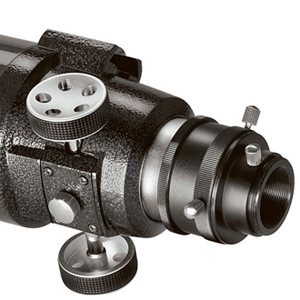
left: Orion ED telescope locking 2" Focuser and Reducer to 1.25". Notice the innovative arrangement of the Focuser Lock, this prevents marring the drawtube as is common with many other telescopes (52,574 Bytes).
Click on image to see enlarged view (88,227 bytes)
a complete working telescope right out of the box!
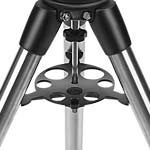
and learn how use the celestial coordinate navigation system developed for astronomy
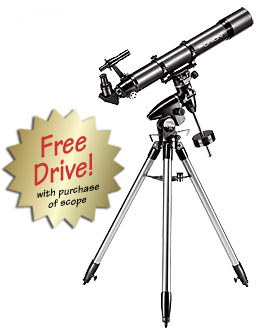
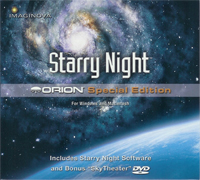 Receive a FREE Starry Night Special Edition software suite. Both the highly acclaimed planetarium software by Imaginova "Starry Night Special Edition" with a bonus "SkyTheatre" DVD are included FREE with purchase of any Orion-brand astronomical telescope from Company Seven.
Receive a FREE Starry Night Special Edition software suite. Both the highly acclaimed planetarium software by Imaginova "Starry Night Special Edition" with a bonus "SkyTheatre" DVD are included FREE with purchase of any Orion-brand astronomical telescope from Company Seven.
Click on image to view enlargement (85,180 bytes).
SKYVIEW PRO™ 100mm ED TELESCOPE SPECIFICATIONS
Specification
Clear aperture:
99.9mm (3.93 Inches)
Design:
Air Spaced ED Doublet Apo
Focal length:
900 mm (35.4 Inches)
Resolution (visual):
1.16 arc seconds
Resolution (photo):
0.75 arc seconds
Coatings:
Multicoated
Light Gathering Power:
about 190X that of unaided eye
Visual Magnitude Limit:
About 12.3
Magnification range:
16x to 240x
Tube assembly construction:
Painted finish, aluminum tube
Tube assembly length with 2/1.25 Reducer:
35.25 inches (895 mm)
Lens Shield Length:
Slip on, 5.3 inches (135 mm)
Lens Shield OD:
4.58 inches (116.46 mm)
Front Cell OD:
4.4 inches (111.8 mm)
Lens Cover Diameter:
4.573 inches (116.15 mm)
Lens Cover Aperture Stop:
2.0 Inches (52 mm)
Weight of OTA:
7.5 lbs. (3.4 kg)
Focuser type:
2 inch Crayford
Focuser Travel:
5.3 inches (134.9mm)
35mm prime-focus field:
2.2 x 1.5 x 2.7 degrees @ f9
35mm field with Focal Reducer:
2.8 x 1.9 x 3.4 degrees (vignetted) @ f5.5
Tripod Height Minimum:
32 inches (81 cm)
Tripod Height Maximum:
40 inches (102 cm)
Equatorial Head Weight
23 lbs. (10.5 kg)
FURTHER READING
To read additional information about the Orion 100mm ED sold by Company Seven feel free to download the Orion SkyView Pro™ 80ED EQ Telescope Instruction Manual. This is the complete 28 page illustrated instruction manual as furnished with our similar 80mm ED telescopes when packaged with the Orion SkyView Pro™ German Equatorial Mount. When the manual is ready for the 100mm ED we will place that on line instead. Publication content by Orion Telescopes and Binoculars, all rights reserved. From Company Seven's Archives. 2,949,488 bytes (in Acrobat Reader ".pdf" format).
C-7'S QUALITY CONTROL SERVICE:
"a series of subtle improvements"
"expert counsel brings value to a transaction, and profit should be the reward for a job well done"
SUGGESTED ACCESSORIES
 Pole Finder Telescope: Astronomers often use a Pole Alignment telescope in a German Mount as an aid to quickly orient the German Equatorial Mount R.A. Axis onto the Celestial North or South Pole. The eyepiece of this small telescope incorporates a reticle pattern that aids Pole alignment of the Mount in both and the Northern and Southern hemispheres. The Orion SkyView Pro™ Mount accepts an optional Polar Alignment Finder telescope. This accessory threads into a fitting on the mount head R.A. Axis shaft. For transport the Pole Alignment Finder is protected by a slop on plastic cover as it protrudes visibly from the mount head and would otherwise be vulnerable to (at the least) misalignment from impact damage.
Pole Finder Telescope: Astronomers often use a Pole Alignment telescope in a German Mount as an aid to quickly orient the German Equatorial Mount R.A. Axis onto the Celestial North or South Pole. The eyepiece of this small telescope incorporates a reticle pattern that aids Pole alignment of the Mount in both and the Northern and Southern hemispheres. The Orion SkyView Pro™ Mount accepts an optional Polar Alignment Finder telescope. This accessory threads into a fitting on the mount head R.A. Axis shaft. For transport the Pole Alignment Finder is protected by a slop on plastic cover as it protrudes visibly from the mount head and would otherwise be vulnerable to (at the least) misalignment from impact damage.
Right: Orion SkyView Pro™ optional Pole Alignment Finder Telescope, eyepiece with focus control is at right end. Click on image for enlarged view (19,867 bytes).
If setting up an equatorial mount in a permanent location, then other techniques can be used to gradually "zero in" a mount onto the Pole to obtain even greater accuracy. However, the Pole Finder is an especially desirable aid to quick alignment for people who are transporting the mount from one location to another.
- Low magnification: for views of the faint deep sky objects a 32mm to 35mm
focal length eyepiece.
- Middle Magnification eyepiece - usually between 80 to 120X, for views
of the full Moon, Star Clusters, etc.
- High magnification: for views of the planets
Fortunately for those on a constrained initial budget, simpler eyepiece designs such as the Plossl, Orthoscopic will work well on this focal ratio telescope. If you prefer to see wider fields of view, and if you require long eye relief (distance from lens to the eye) to accommodate spectacles, then Company Seven recommends eyepieces of advanced designs such as those pioneered by Al Nagler, founder of the TeleVue company. TeleVue's advanced designs include the "Nagler", "Radian", or "Panoptic" series eyepieces. These oculars will provide the widest clear, and flat field images bringing out the most in your telescope (and many other) telescopes. For manually driven mounts in particular, wider field of views are also desirable since as the Earth rotates and objects drift across the field of view, a wide angler ocular shows an object for some time longer before having to adjust the telescope.
Please refer to the brochure and the test report/data from Company Seven enclosed with the telescopes we deliver for detailed characterizations of many suggested eyepieces:
| Eyepiece | Magnification | Actual field of view | Exit pupil |
|---|---|---|---|
| 55mm Plossl (2" eyepiece) | 11x | 4.4 degrees | 7.3mm |
| 35mm Panoptic (2" eyepiece) | 17x | 3.7 degrees | 4.67mm |
| 32mm Plossl | 19x | 2.6 degrees | 4.3mm |
| 27mm Panoptic (2" eyepiece) | 22x | 2.9 degrees | 3.6mm |
| 22mm Nagler (2" eyepiece) | 27x | 3 degrees | 2.9mm |
| 15mm Plossl | 50x | 1.2 degrees | 2.0mm |
| 8mm Radian | 101x | 0.59 degrees | 0.9mm |
| 6mm Radian | 100x | 0.6 degrees | 0.8mm |
| 5mm Nagler | 120x | 0.67 degrees | 0.7mm |
| 3mm Radian | 300x | 0.3 degrees | 0.4mm |
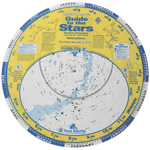 David H. Levy Guide to the Stars Planisphere If you are not familiar with the night sky then Company Seven recommends you buy a good simple Planisphere which makes it very easy for one to find out what constellations and major deep sky objects are overhead at any given time of the day or night.
David H. Levy Guide to the Stars Planisphere If you are not familiar with the night sky then Company Seven recommends you buy a good simple Planisphere which makes it very easy for one to find out what constellations and major deep sky objects are overhead at any given time of the day or night.
The night sky is mapped with the Constellations being those patterns recognizable to man since time immemorial. Constellations can be thought of as countries or states on a world map, where if you seek the Grand Canyon then you know to find Arizona. While in the night sky when one seeks the Great Nebula then one looks toward the Constellation Orion. The Planisphere is a two piece assembly consisting of one disc with a chart of the entire night sky, and an attached overlay disc with a transparent window and surrounding mask to simulate the horizons. The overlay is dialed to line up its local time indicator marks with the Month and Day printed around the edge of the chart disc, and so when properly set this will reveal what parts of the sky may be seen at any time of the year. The print is easy to read under day or red light.
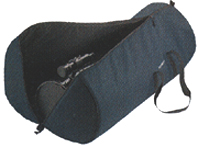
The telescope is available assembled and precisely collimated by Company Seven's experienced staff. The telescope includes the Orion One Year Limited Warranty and this is complimented by Company Seven's own guarantees and service facilities. With proper use and maintenance, there is very little that can go wrong with a telescope such as this - if there is a problem then it is likely we will have found it for you and so with the exception of normal wear and tear, or Diagonal mirror coating, Company Seven backs our telescopes for life.